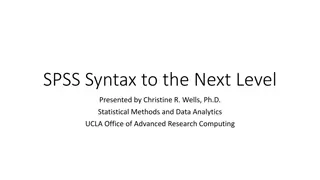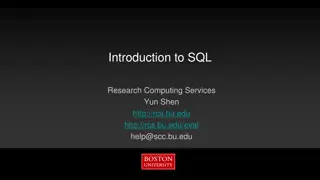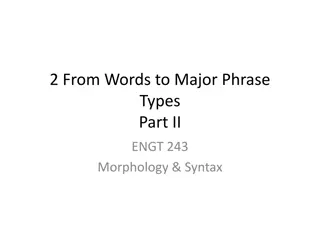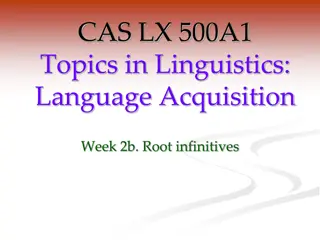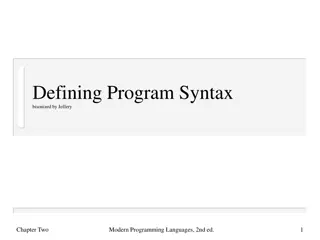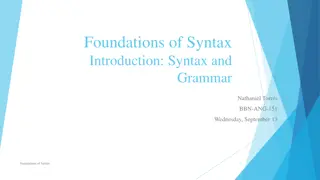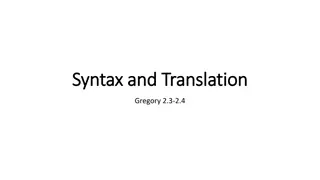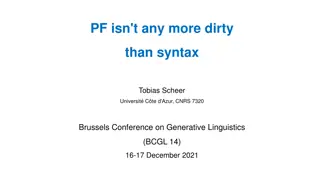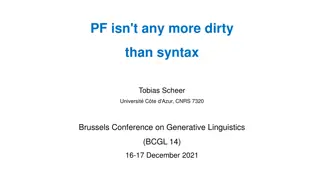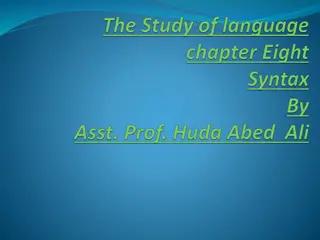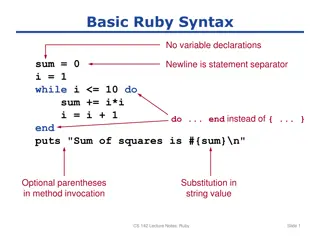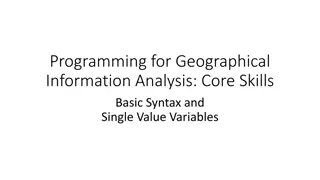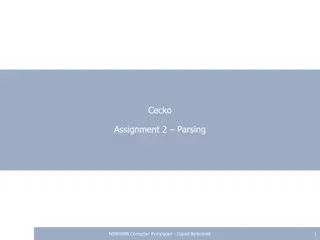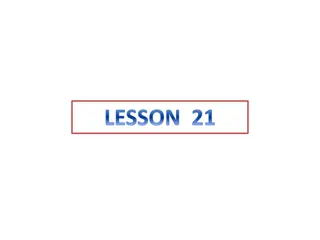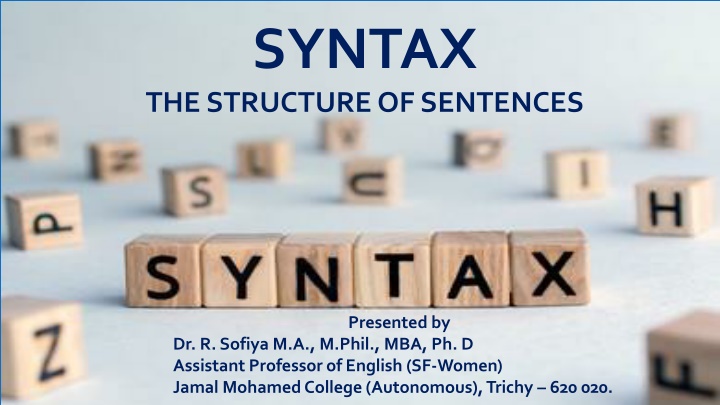
Syntax: Study of Sentence Structure and Word Arrangement
Explore the definition, importance, basic concepts, and types of sentences in the study of syntax presented by Dr. R. Sofiya. Learn about phrases, clauses, sentence patterns, and the organization of words into meaningful structures within a sentence.
Download Presentation

Please find below an Image/Link to download the presentation.
The content on the website is provided AS IS for your information and personal use only. It may not be sold, licensed, or shared on other websites without obtaining consent from the author. If you encounter any issues during the download, it is possible that the publisher has removed the file from their server.
You are allowed to download the files provided on this website for personal or commercial use, subject to the condition that they are used lawfully. All files are the property of their respective owners.
The content on the website is provided AS IS for your information and personal use only. It may not be sold, licensed, or shared on other websites without obtaining consent from the author.
E N D
Presentation Transcript
SYNTAX THE STRUCTURE OF SENTENCES Presented by Dr. R. Sofiya M.A., M.Phil., MBA, Ph. D Assistant Professor of English (SF-Women) Jamal Mohamed College (Autonomous), Trichy 620 020.
Definition of Syntax Syntax is the study of sentence structure and the arrangement of words. It defines how words are combined to form grammatically correct sentences. It plays a role in both spoken and written language.
Importance of Syntax Helps form clear and coherent sentences. Provides rules that enable mutual understanding. Essential in both everyday language use and advanced language studies.
Basic concepts in Syntax Phrases: Groups of words acting as a unit within a sentence. Clauses: Groups containing a subject and a verb. Sentence: A full thought expressed with a subject and predicate. Syntax studies how these elements interact to form meaning.
Phrase Structure in Syntax Syntax organizes words into meaningful phrases. Phrases function as building blocks for creating larger sentence structures. Common types include noun, verb, and prepositional phrases.
Basic Sentence Patterns SVO (Subject-Verb-Object): Predominant in English and many other languages. SOV (Subject-Object-Verb): Used in languages like Japanese. VSO (Verb-Subject-Object): Found in languages like Arabic. Different languages follow different sentence structures.
Types of Sentences Simple Sentence: Contains one independent clause (e.g. She laughs ). Compound Sentence: Contains two or more independent clauses, often joined by conjunctions (e.g. She laughs, and he smiles ). Complex Sentence: An independent clause combined with one or more dependent clauses (e.g. She laughs because she s happy ). Compound-Complex Sentence: Combines multiple independent and dependent clauses (e.g. She laughs because she s happy, and he smiles ).
Phrase Types in Syntax Noun Phrase (NP): Functions as a subject or object (e.g. The big dog ). Verb Phrase (VP): The main verb and any auxiliaries (e.g. is running fast ). Adjective Phrase: Modifies a noun (e.g. extremely bright ). Adverb Phrase: Modifies verbs, adjectives or other adverbs (e.g. quite quickly ). Prepositional Phrase: Begins with a preposition, showing relationships (e.g. under the table ).
Phrase Structure Rules Rules that determine how phrases are structured. For example, Noun Phrase (NP) might include a determiner + noun (e.g. "the car"). Verb Phrase (VP) could include an auxiliary + verb (e.g. "has been running"). Helps form consistent, grammatically correct phrases.
Syntax Trees: Visualizing Sentence Structure Syntax trees show hierarchical sentence structures. They visually represent relationships between words and phrases. Useful for breaking down complex sentences and analysing syntactic components.
Constituents in Syntax Constituents are groups of words that form a single unit in syntax. Examples include noun phrases, verb phrases and prepositional phrases. Constituents form the framework of sentence structure.
Syntactic Ambiguity When a sentence can have multiple meanings due to its structure. Example: "Flying planes can be dangerous" (can mean "Planes that fly are dangerous" or "The act of flying planes is dangerous"). Emphasizes the need for careful syntax to avoid misinterpretation.
Word Order in Syntax Word order affects meaning and grammaticality. Different languages use distinct orders (e.g. English uses SVO). Deviations in word order can create emphasis or stylistic effects in language.
Transformational Grammar (Noam Chomsky) Developed by linguist Noam Chomsky to explain sentence formation. Focuses on how deep structures (underlying meanings) transform into surface structures (actual sentences). Influential in understanding sentence complexity and variability.
Types of Clauses Independent Clause: A complete thought (e.g. She laughs ). Dependent Clause: Cannot stand alone (e.g. because she s happy ). Relative Clause: Provides additional information (e.g. who was laughing ). Clauses are central to creating complex sentence types.
Agreement in Syntax Ensures correct matching between subjects and verbs. Agreement includes singular/plural forms (e.g. "She runs" vs. "They run"). Essential for grammatical accuracy and clarity.
Syntax Analysis: Parsing Sentences Parsing involves breaking down sentences into components. Identifies parts of speech, phrases and syntactic rules. Used in language processing, computational linguistics and AI.
Examples of Syntax in Different Languages English: SVO structure ( I eat food ). Japanese: SOV structure ( I food eat ). Arabic: VSO structure ( Eat I food ). Highlights syntactic diversity across global languages.
Applications of Syntax Study Language Teaching: Simplifies grammar instruction. AI and Natural Language Processing (NLP): Enhances machine understanding of human language. Linguistic Research: Reveals patterns and differences across languages. Useful in fields from education to technology.
Conclusion Syntax is fundamental to understanding language structure. It enables clear, coherent communication. Essential for language learning, AI and linguistic research. Continues to impact various fields, including linguistics and cognitive science.


